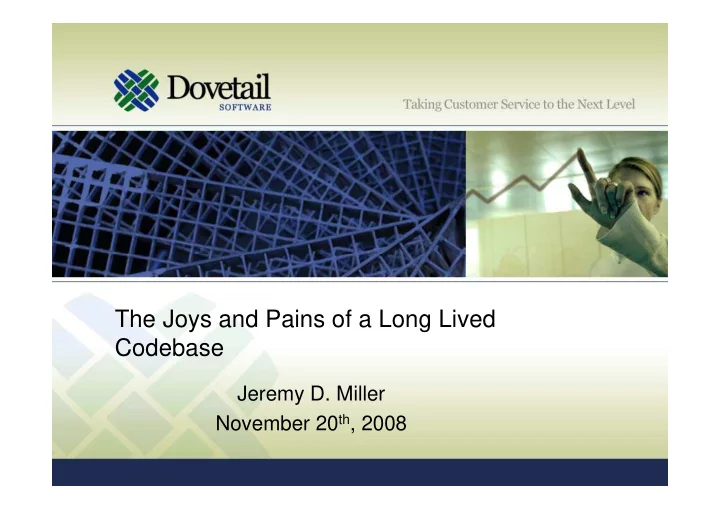

The Joys and Pains of a Long Lived Codebase Jeremy D. Miller November 20 th , 2008
About Me � Chief Software Architect at Dovetail Software in Austin, TX � Author of StructureMap ♦ http://structuremap.sourceforge.net � “The Shade Tree Developer” � “The Shade Tree Developer” ♦ http://codebetter.com/blogs/jeremy.miller � jeremydmiller@yahoo.com
What is StructureMap? � Inversion of Control / Dependency Injection tool for .Net � Open Source under the Apache 2.0 license � I’m the primary author …this isn’t really about StructureMap itself
The Journey So Far � Recovering data centric VB6 developer to… � StructureMap was originally released in 2004 � TDD was new in .Net circles � .Net 1.1 to .Net 2.0 to .Net 3.5 � The “Python 3000” Release in 2008 � The “Python 3000” Release in 2008
What has Changed? � Lower tolerance for ceremony � Programmatic configuration is now favored over Xml configuration � More complicated usage ♦ Composite configuration ♦ Composite configuration ♦ Interception � Convention over Configuration � Explicit Configuration vs. Just Let it Work � Language innovation
What Have I Learned? � Solid design in the small is crucial � To organize and structure by behavior � Automated test coverage isn’t automatically effective � Some nasty lessons about creating API’s for other developers developers
Don’t Repeat Yourself � It’s 2005, and Generics are all the rage in .Net � Wouldn’t it be nice if StructureMap could support open generic types… � Lesson Learned: Even innocuous looking duplication can be harmful
Encapsulation is Key
Vile, Evil Code public class ClassWithFoos { private readonly IDictionary<string, Foo> _foos = new Dictionary<string, Foo>(); public IDictionary<string, Foo> Foos { get { return _foos; } } }
Keep the Code Limber � Watch for similar code � Use static code analysis as another pair of eyes � Reduce the size of the codebase
Better Abstractions � “Noun” based design is naïve � Design abstractions by responsibilities and roles � Use object role stereotypes
“The Great Refactoring of Aught Eight” Before After � InstanceManager � Container � InstanceFactory � InstanceFactory (simpler) � InstanceMemento � InstanceMemento � Instance � Instance � BuildSession � PipelineGraph � BuildPolicy
Test Driven Development allows for modifiability… …if done well
Organizing Tests � 1 Concrete Class == 1 TestFixture (Not!) � TestFixture per Feature � Arriving at Behavior Driven Development ♦ Number of Assertions per Test ♦ Pay attention to the “language” of tests Pay attention to the “language” of tests ♦ Emphasize scenarios over units of code ♦ Test what you’re testing
Test Input � Ideally, tests should be self-contained � Use meaningful test data � Watch the Expensive Test Setup Smell � Invest in ObjectMothers or Test Data Builders � Be extremely cautious in reusing test data across multiple � Be extremely cautious in reusing test data across multiple tests
Building Configuration Intensive Frameworks � Isolate functionality from configuration � Isolate the user from framework internals � Fail Fast � Diagnostics are Important
Crafting Good API’s � Essence vs. Ceremony � The Pit of Success � Consistency � Predictability � Discoverability � Discoverability � Readability / Understandability
Takeaways � Keep your code clean � Make sure your abstractions match reality, and reality changes over time � Minimize ceremony � Test behaviors, not implementation details � Test behaviors, not implementation details � Good tests are readable tests
Recommend
More recommend